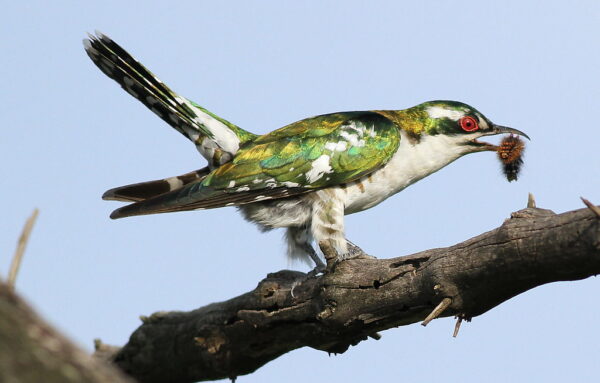Scientific Name: Cuculidae Family
Physical Traits
- Size: Varies depending on species, ranging from 6.3 inches (16 cm) to 28 inches (70 cm) in length
- Color: Diverse colors and patterns, from subdued browns and grays to vibrant greens, blues, and reds
- Body Structure: Generally slender bodies with long tails, stout bills, and strong legs; some species, like the roadrunners and coucals, have unique adaptations
Life Span
- In the Wild: Typically 3-6 years, depending on the species
- In Captivity: Can vary depending on species and care provided
Habitat
- Geographical Range: Found worldwide, with species inhabiting Europe, Asia, Africa, and Australia
- Preferred Environment: Diverse habitats, including forests, grasslands, wetlands, and even deserts
Diet
- Main Food Source: Omnivorous, feeding on insects, caterpillars, fruit, seeds, and small vertebrates; diet varies depending on species
- Foraging Behavior: Active hunters, using their keen vision and agility to catch prey
Reproduction
- Breeding Season: Varies depending on species and location
- Eggs: Typically 1 egg laid in the host’s nest, with egg color and pattern mimicking those of the host species
- Brood Parasitism: Cuckoos are known for their unique reproductive strategy, laying their eggs in the nests of other bird species and relying on the host parents to raise their chicks
Conservation Status
- IUCN Red List: Conservation status varies depending on species, with some species listed as Least Concern (LC), while others are considered Near Threatened (NT), Vulnerable (VU), or Endangered (EN)
- Population Trend: Some cuckoo populations are stable, while others face declines due to habitat loss, climate change, and other human-related factors
Interesting Facts
- Distinctive Call: Male cuckoos have a characteristic two-note call, “cu-ckoo,” which changes pitch as the bird ages
- Global Distribution: Cuckoos are found across the world, with over 140 species belonging to the Cuculidae family
- Indicator Species: Cuckoos can act as indicators of environmental health, with their presence reflecting the overall health of their ecosystem
- Chick Behavior: Upon hatching, cuckoo chicks often push the host’s eggs or chicks out of the nest to ensure they receive all the resources and attention from the host parents
- Migration: Some cuckoo species, like the common cuckoo, are migratory, traveling long distances between their breeding and wintering grounds

